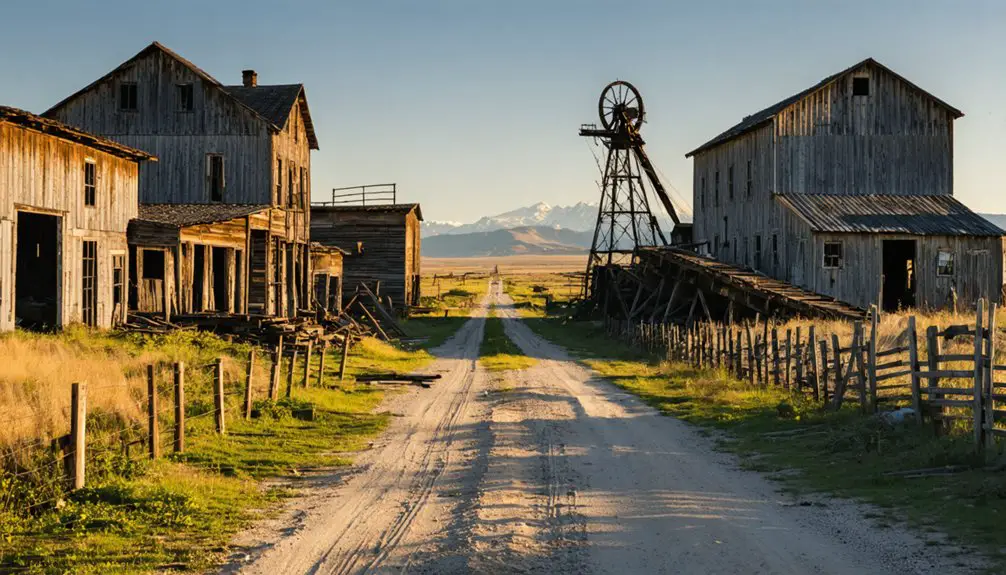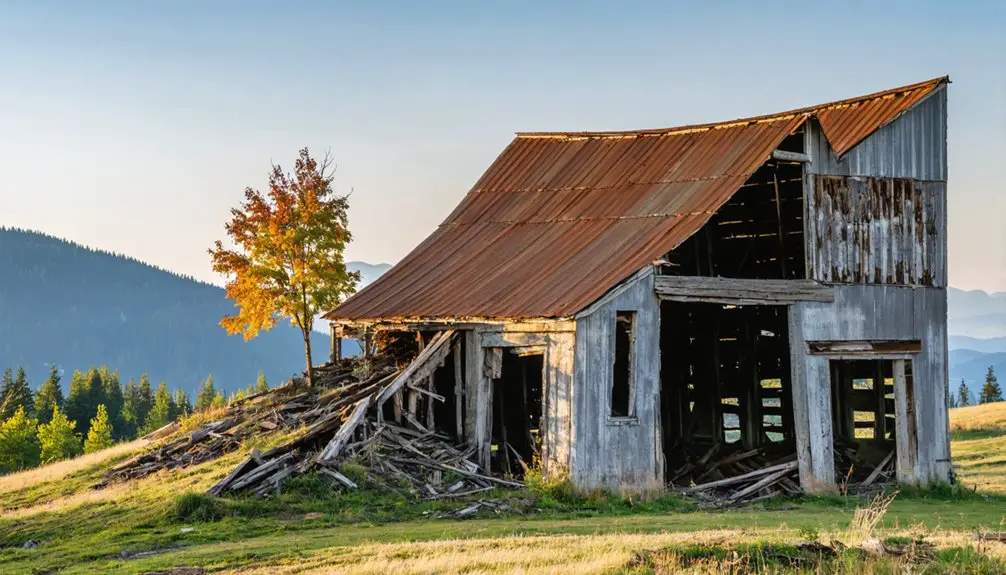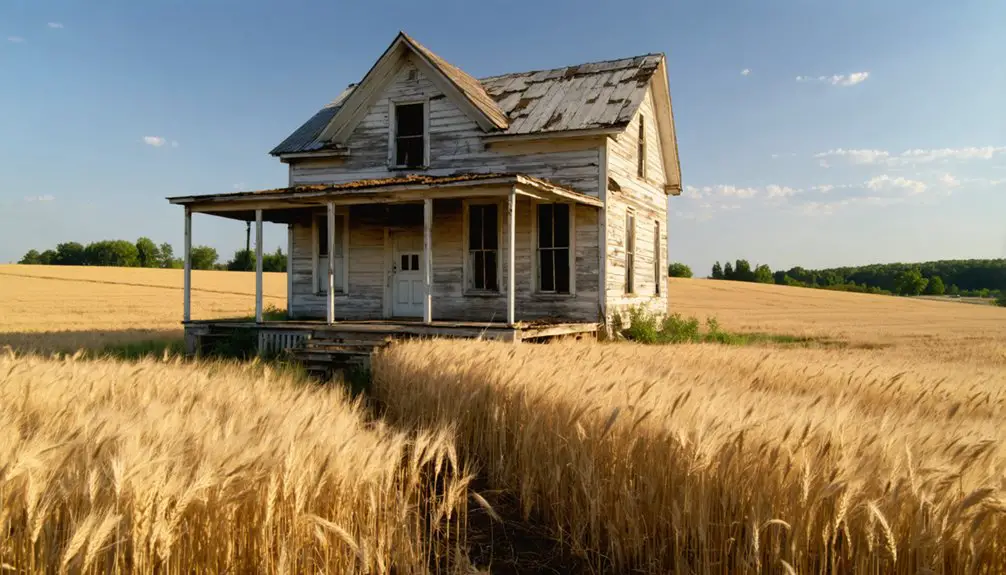You’ll find Brief, Washington – a gold mining ghost town from 1892 – tucked into Snohomish County where Money Creek meets the South Fork Skykomish River. This bustling settlement once boasted two hotels, two saloons, and two stores across 15 town blocks, serving as an essential hub for prospectors. Today, you can explore the remnants along ancient Native American trading routes, where mining equipment and foundations tell stories of Washington’s golden age.
Key Takeaways
- Brief was a mining community in Washington State’s Central Cascades, established during the late 19th-century mining boom.
- The town featured essential mining infrastructure, including stamp mills, ore processing facilities, and transportation networks.
- Located near current-day Stevens Pass, Brief was accessible via mountain routes that connected to other mining settlements.
- Mining operations focused on gold and silver extraction, employing specialized equipment and processing methods for ore refinement.
- Today, Brief exists as a ghost town with remaining foundations, mining equipment ruins, and hiking trails for visitors.
The Rise of a Mining Settlement
Although prospectors had been exploring the Silver Creek Mining District since 1871, Mineral City didn’t officially emerge until 1892 when Elisha Hiram Hubbart filed the townsite in Snohomish County, Washington.
You’ll find this mining community was strategically positioned along ancient Native American routes used by the Skykomish and Sauk peoples, within the promising Anna Quartz mining claim area. Like many western mining settlements, Mineral City would eventually become a ghost town after mining activity declined. Similar to the Law and Order of the Highlands building that operated in the region from 1896 to 1972, the town maintained a strong presence in the area for many decades.
The settlement’s historical significance grew as it expanded to 15 town blocks, featuring essential establishments including two hotels, two saloons, and two stores.
You’d have found a bustling hub that served as both a supply center and a gathering point for prospectors. The town’s boarding house even served as a voting precinct in the 1880 presidential election, showcasing the community’s rapid development into an organized settlement.
Mining Operations and Discoveries
You’ll find the origins of Brief’s mining boom in the 1889 discoveries along Seventysix Gulch, where Joseph Pearsall’s initial gold strike sparked an immediate rush of claim-staking.
Similar to famous mining towns like Monte Cristo, Brief’s miners employed lode mining techniques that required extensive drilling and blasting equipment to extract gold and silver from the hard mountain rock. Aerial tramways transported the ore from high elevation mines down to the processing facilities.
Your understanding of Brief’s operations wouldn’t be complete without noting their ore processing methods, which utilized crushers, roll rollers, and water wash jigs to concentrate the precious metals before shipping them via narrow gauge railway to Everett’s smelters.
Initial Gold Strike
The fateful summer of 1889 marked Monte Cristo’s transformation when prospectors Joe Pearsall and Frank Peabody discovered a rich gold and silver vein in the western Cascade Range. This gold discovery triggered a wave of fortune seekers from Lewiston, Washington, and Oregon, who rushed to stake their claims in the promising terrain.
The number of mining claims exploded rapidly, growing from just 13 mines and 40 claims in 1891 to an impressive 211 claims by 1893. Historical evidence of mining activities can still be seen today through carbide graffiti dated 1946 preserved in various tunnel sections.
Among the early pioneers was Adam Carrico, whose stakes in Gold Creek helped establish the area’s first mining villages. The discovery by Captain E.D. Pierce in 1852 set the foundation for mining exploration in the region.
You’ll find it interesting that Chinese placer miners had already worked the region’s sand and gravel deposits back in the 1860s, particularly in the nearby Methow Valley.
Mining Equipment Used
Mining operations at Monte Cristo required sophisticated equipment to process the rich gold and silver deposits.
You’ll find evidence of massive crushers and roll rollers that broke down ore from the host rock, while water wash jigs separated valuable mineral particles. The mill’s stone foundations reveal where stationary mining machinery once stood, processing tons of material daily.
The site utilized an intricate system of conveyors and transport mechanisms to move crushed ore toward smelting locations in Everett. A powerful 200 horsepower engine drove the mill’s extensive machinery operations. The mine produced an impressive 200,000 tons per year during peak operations under Pacific Coast Company ownership.
Today, you can still spot equipment remnants throughout the area, including rusty machinery parts uncovered during remediation efforts.
The preserved stone foundations and structural ruins demonstrate the impressive scale of Monte Cristo’s mining infrastructure, offering glimpses into the sophisticated engineering that powered this once-bustling operation.
Ore Processing Methods
Sophisticated ore processing defined Monte Cristo’s mineral extraction operations, with miners deploying an array of specialized equipment to separate valuable metals from host rock.
You’d find crushers and roll rollers breaking down the ore, while water wash jigs separated valuable concentrates from waste material. The system relied on aerial tramways to transport ore from high-elevation mines like Mystery Hill down to the United Companies’ concentrator in town. In 1934, they constructed a 50-ton capacity mill that enhanced their processing capabilities.
The first infrastructure built included the number two shaft, which measured 106 by 188 feet and revealed prominent coal veins along the hillside.
The mineral recovery process targeted lode deposits rich in gold and silver, requiring intensive drilling and blasting.
Though initial estimates suggested 85% efficiency in metal extraction, actual recovery rates proved lower. After concentration, the ore moved by rail to Everett’s smelters for final processing, with the Pride of the Mountains and Golden Cord mines leading production.
Life in Early Bodie
If you’d visited Bodie during its prime in the 1890s, you’d have found a bustling community centered around the stamp mill, with miners working claims while merchants, hoteliers, and shopkeepers served the town’s daily needs.
The presence of a school, post office, and telegraph service showed that Bodie wasn’t just a camp but a proper settlement where families put down roots alongside the single miners.
The town’s social life revolved around its two-story hotel and saloon, while regular stagecoach service three times weekly kept residents connected to neighboring communities.
Daily Mining Town Operations
During the late 19th century, Bodie’s daily operations centered around a complex network of mining activities that employed nearly 800 workers and their families.
You’d find miners descending 1,200-foot shafts in the Standard Mine, while others maintained essential mining equipment like the powerful Cornish pumps that kept the tunnels dry.
The Standard Company’s mill dominated ore processing, changing from steam power to electricity in 1893.
Workers operated stamp mills to crush ore, first using mercury amalgamation and later adopting more efficient cyanide processing methods.
You’d see stacks of cordwood fueling the steam-powered machinery until the installation of a 12.5-mile electric transmission line from nearby hydroelectric plants revolutionized operations.
This technological shift helped the Standard Company become the district’s most profitable mine, producing over $18 million in precious metals.
Population and Social Structure
While Bodie’s population never reached the staggering numbers of larger mining towns, its social fabric wove together a diverse mix of residents during its peak around 1900. You’d have found about 300 people calling Bodie home, including miners, merchants, and their families.
The community dynamics centered around key gathering spots – the hotel, saloon, general store, and schoolhouse – where residents shared news and strengthened social bonds.
The transient population of miners ebbed and flowed with the ore’s fortunes, but the presence of families helped maintain stability through the town’s institutions.
While men dominated the workforce in mining operations, women and children brought balance to the community, supporting local businesses and keeping the schoolhouse active.
The town’s newspaper kept everyone connected, broadcasting both triumphs and challenges of frontier life.
Transportation and Access Routes

Three primary routes provide access to Wellington Ghost Town, with State Route 2 serving as the main arterial highway to Stevens Pass.
You’ll need to navigate the Old Cascade Highway and Tye Road before encountering a challenging 2.5-mile dirt road that leads to the site. Access challenges include rough terrain that demands high-clearance or four-wheel drive vehicles.
For visitor preparation, you’ll want to bring physical maps or download offline navigation apps, as cell coverage is spotty throughout the area.
While you can park near the site, the Iron Goat Trail offers an alternative hiking route. Don’t count on public transportation – you’ll need your own vehicle to reach this remote location.
Remember to fuel up and gather supplies in nearby Skykomish, as amenities are limited at the destination.
Geographic Features and Terrain
Perched within Washington’s Central Cascades region, Wellington Ghost Town occupies a unique topographical setting characterized by gentle valley slopes and forested foothills.
You’ll encounter modest elevation gains of about 20 feet over two-mile stretches as you explore the terrain, which features remnants of the area’s mining heritage including stone foundations and weathered cart tracks.
The landscape’s geological formations tell a compelling story through exposed mine shafts, tunnels, and locally-sourced stone walls.
Weathered rocks and human ingenuity merge in Wellington’s network of tunnels, mines, and stone structures, revealing centuries of geological interaction.
You’ll find yourself surrounded by moss-draped forests and seasonal meadows, while the nearby river valleys that once dictated railway routes continue to shape the land.
These watercourses have left their mark through visible bridge abutments and eroded banks, creating a dynamic terrain that’s constantly evolving through natural processes.
The Ghost Town Experience Today

As you traverse the remnants of Washington’s ghost towns today, you’ll find a range of experiences from barren sites with minimal remains to semi-abandoned communities still harboring a few residents.
Most ghost town accessibility requires some effort – you’ll need to hike trails like the 8-mile round trip to Monte Cristo or navigate unpaved roads stretching 3-4 miles from main thoroughfares.
Your visitor experience might include exploring rusted mining equipment, crumbling foundations, and weather-worn buildings preserved in “arrested decay.”
While some sites feature interpretive signs and historical markers to guide your journey, you’ll need to watch your step – many structures are unstable.
Pack accordingly, as amenities are sparse, with few locations offering formal parking or facilities.
Seasonal road closures may also impact your visit.
Notable Historical Events
During Washington’s late 19th and early 20th centuries, several once-thriving communities transformed into ghost towns through dramatic cycles of boom and bust.
You’ll find ghostly legends surrounding Govan’s unsolved murders from the 1900s, where the abandoned schoolhouse stands as one of the few historical markers of its railway-dominated past.
In Molson, the cemetery serves as a silent memorial to the town’s brief but intense mining boom that saw its population soar to 300 before plummeting just as quickly.
Monte Cristo’s legacy includes over 200 mining claims and the tragic loss of the Boston American Mining Company Cook House to fire in 1983.
Each town’s story weaves together themes of ambition, struggle, and eventual abandonment that shaped Washington’s frontier development.
Preservation Status and Remnants

While many Washington ghost towns have succumbed to time and neglect, several preservation organizations work diligently to protect these historic sites.
You’ll find dedicated groups like the Monte Cristo Preservation Association leading efforts to maintain public access roads and protect remaining structures. Since the early 1990s, the U.S. Forest Service has managed many former resort properties, though some private mining claims still present stewardship challenges.
You can explore numerous physical remnants throughout Washington’s ghost towns. Monte Cristo features rusting mining equipment and abandoned buildings along hiking trails, while Liberty retains several historically significant structures.
For visitor access, you’ll need to hike an 8-mile roundtrip from Barlow Pass to reach Monte Cristo, though some sites like Liberty offer nearby campgrounds for extended stays.
Exploring Bodie’s Mining Legacy
Once the Standard Company discovered profitable ore in 1876, Bodie established itself as one of California’s most productive mining towns, yielding over $34 million in gold and silver during its run.
The Standard Mine alone produced more than half of that wealth, extracting ore from fissure veins that reached depths of 1,200 feet.
Bodie’s mining legacy showcases remarkable technological innovation – you’ll find evidence of both early stamp mills using mercury amalgamation and later cyanide processing methods.
The town’s mining culture embraced progress, becoming the first California industrial site to utilize long-distance electric power transmission in 1893.
As you explore Bodie’s remains, you’ll discover how its miners adapted to changing conditions, from processing high-grade ore to reprocessing tailings as the quality declined.
Frequently Asked Questions
What Wildlife Can Visitors Commonly Encounter Around the Bodie Ghost Town Area?
You’ll spot wildlife sightings of jackrabbits, ground squirrels, and mule deer during your visit, while coyotes often display hunting behavior. Chipmunks scurry around buildings, and sage grouse frequent scrubland areas.
Are There Any Documented Paranormal Activities or Ghost Stories From Bodie?
Where shadows dance in forgotten mines, you’ll find documented ghost sightings of miners haunting Bodie’s ruins. You can hear phantom footsteps and witness unexplained phenomena around abandoned shafts and buildings.
What Is the Best Season to Visit Bodie for Photography?
You’ll get your best shots from late May through mid-October. June offers dramatic thunderstorm skies and rainbows, while October’s cold nights deliver stunning Milky Way photography with green airglow.
Were There Any Famous Outlaws or Notable Crimes in Bodie?
You’ll find the “Bad Man from Bodie,” John Franklin Showers, among the town’s most feared outlaws. With 65 saloons fueling frequent gunfights, stagecoach robberies, and murders, Bodie’s notorious crimes defined its legacy.
Did Any Prominent Mining Families From Bodie Establish Legacies Elsewhere?
You’ll find that Bodie descendants expanded their mining legacies into Montana, Arizona, and Utah, leveraging their wealth and expertise to establish new ventures in emerging boomtowns after Bodie’s decline.
References
- https://en.wikipedia.org/wiki/Bodie
- https://stateofwatourism.com/ghost-towns-of-washington-state/
- https://www.youtube.com/watch?v=FVveO9uJBvc
- https://everydayspokane.com/ghost-towns-in-washington-state/
- https://www.wta.org/go-outside/seasonal-hikes/fall-destinations/hidden-history-ghost-town-hikes
- https://en.wikipedia.org/wiki/Mineral_City
- https://www.youtube.com/watch?v=2Saj0oIS4tc
- https://westernmininghistory.com/towns/washington/barron/
- https://www.historylink.org/File/22479
- https://www.aol.com/ghost-towns-sit-abandoned-across-204352655.html



